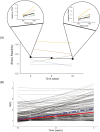Changes in daily stress reactivity and changes in physical health across 18 years of adulthood
- PMID: 39729502
- PMCID: PMC11761442
- DOI: 10.1093/abm/kaae086
Changes in daily stress reactivity and changes in physical health across 18 years of adulthood
Abstract
Background: Stress plays a pivotal role in physical health. Although many studies have linked stress reactivity (daily within-person associations between stress exposure and negative affect) to physical health outcomes, we know surprisingly little about how changes in stress reactivity are related to changes in physical health.
Purpose: The current study examines how change in stress reactivity over 18 years is related to changes in functional health and chronic health conditions.
Methods: Three measurement bursts from the National Study of Daily Experiences (N = 2880; 55% female) each included daily measures of stressor exposure and negative affect across 8 consecutive days, yielding 33 944 days of data across 18 years of adulthood. At each wave, participants reported their functional health limitations (ie, basic activities of daily living [ADL] and instrumental activities of daily living [IADL]) and chronic health conditions. Multilevel structural equation models simultaneously modeled stress reactivity at Level 1, longitudinal changes in stress reactivity at Level 2, and the association between changes in stress reactivity and changes in functional limitations and chronic conditions at Level 3.
Results: Higher levels of stress reactivity at baseline were associated with more functional health limitations 18 years later (ADLs: Est. = 0.90, P = .001; IADLs: Est. = 1.78, P < .001). Furthermore, individuals who increased more in their stress reactivity across the 18-year period also showed greater increases in their functional health limitations (ADLs: Est. = 4.02, P = .017; IADLs: Est. = 5.74, P < .001) and chronic conditions (Est. = 11.17, P = .008).
Conclusions: These findings highlight the strong connection between health and stress in daily life, and how they travel together across adulthood.
Keywords: chronic conditions; daily diary; functional health; multilevel SEM; stressor reactivity.
Plain language summary
Emotional reactivity to minor daily stressors has been shown to play a role in physical health, where individuals who are more reactive tend to also have poorer health. However, emotional reactivity to stress also changes across the lifespan with some people becoming more reactive over time and others becoming less reactive or remaining stable. The current study examines how change in stress reactivity over 18 years of adulthood is related to changes in functional health and chronic health conditions. Using data from the National Study of Daily Experiences, emotional responses to daily stressors were measured in 2880 individuals, capturing 33 944 days of data across 18 years of adulthood. Findings from this study indicate that individuals who were initially more reactive to daily stressors had greater functional health limitations 18 years later. Importantly, individuals who became more emotionally reactive to daily stressors across the 18-year period also experienced greater increases in their functional health limitations and number of chronic health conditions compared to individuals who were stable or became less emotionally reactive to daily stressors. These findings highlight the strong connection between health and stress in daily life, and how they travel together across adulthood.
© The Author(s) 2024. Published by Oxford University Press on behalf of the Society of Behavioral Medicine.
Conflict of interest statement
None declared.
Figures



Similar articles
-
Age and Sex Differences in the Associations Among Socioeconomic Status, Affective Reactivity to Daily Stressors, and Physical Health in the MIDUS Study.Ann Behav Med. 2023 Oct 16;57(11):942-950. doi: 10.1093/abm/kaad034. Ann Behav Med. 2023. PMID: 37369129 Free PMC article.
-
Let It Go: Lingering Negative Affect in Response to Daily Stressors Is Associated With Physical Health Years Later.Psychol Sci. 2018 Aug;29(8):1283-1290. doi: 10.1177/0956797618763097. Epub 2018 Mar 19. Psychol Sci. 2018. PMID: 29553880 Free PMC article.
-
Daily emotional and physical reactivity to stressors among widowed and married older adults.J Gerontol B Psychol Sci Soc Sci. 2014 Jan;69(1):19-28. doi: 10.1093/geronb/gbt035. Epub 2013 May 18. J Gerontol B Psychol Sci Soc Sci. 2014. PMID: 23685921 Free PMC article.
-
Psychological vulnerability to daily stressors in old age: Results of short-term longitudinal studies.Z Gerontol Geriatr. 2015 Aug;48(6):517-23. doi: 10.1007/s00391-015-0935-7. Epub 2015 Jul 25. Z Gerontol Geriatr. 2015. PMID: 26208576 Review.
-
Folic acid supplementation and malaria susceptibility and severity among people taking antifolate antimalarial drugs in endemic areas.Cochrane Database Syst Rev. 2022 Feb 1;2(2022):CD014217. doi: 10.1002/14651858.CD014217. Cochrane Database Syst Rev. 2022. PMID: 36321557 Free PMC article.
Cited by
-
Interrelations between daily stress processes and Big Five personality trait changes over 20 years.Psychol Aging. 2025 Jun 26:10.1037/pag0000912. doi: 10.1037/pag0000912. Online ahead of print. Psychol Aging. 2025. PMID: 40569746
-
Disparities in Chronic Stress Exposure and Appraisal and Later-Life Disability.Innov Aging. 2025 Apr 4;9(5):igaf024. doi: 10.1093/geroni/igaf024. eCollection 2025. Innov Aging. 2025. PMID: 40454423 Free PMC article.
References
-
- Sin NL, Graham-Engeland JE, Ong AD, Almeida DM.. Affective reactivity to daily stressors is associated with elevated inflammation. Health Psychol. 2015;34:1154-1165. https://doi.org/ 10.1037/hea0000240 - DOI - PMC - PubMed
-
- Piazza JR, Charles ST, Sliwinski MJ, Mogle J, Almeida DM.. Affective reactivity to daily stressors and long-term risk of reporting a chronic physical health condition. Ann Behav Med. 2013;45:110-120. https://doi.org/ 10.1007/s12160-012-9423-0 - DOI - PMC - PubMed
-
- Almeida DM, Rush J, Mogle J, Piazza JR, Cerino E, Charles ST.. Longitudinal change in daily stress across 20 years of adulthood: results from the national study of daily experiences. Dev Psychol. 2023;59:515-523. https://doi.org/ 10.1037/dev0001469 - DOI - PMC - PubMed
-
- Payette H, Gueye NR, Gaudreau P, Morais JA, Shatenstein B, Gray-Donald K.. Trajectories of physical function decline and psychological functioning: the Quebec longitudinal study on nutrition and successful aging (NuAge). J Gerontol B Psychol Sci Soc Sci. 2011;66:i82-i90. https://doi.org/ 10.1093/geronb/gbq085 - DOI - PubMed
-
- Maresova P, Javanmardi E, Barakovic S, et al. Consequences of chronic diseases and other limitations associated with old age – a scoping review. BMC Public Health. 2019;19:1431. https://doi.org/ 10.1186/s12889-019-7762-5 - DOI - PMC - PubMed

